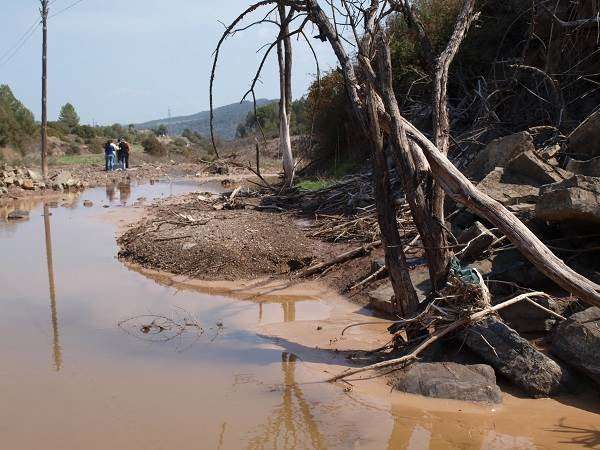One out of three rivers in the Iberian Peninsula is affected by salinization

One out of three rivers in the Iberian Peninsula are highly salinized mainly due the impact of agricultural activity and urbanization. This environmental problem will affect hydric ecosystems due global warming, the growing use of water and the exploitation of soil natural resources.
These are some of the dangers revealed in a special volume on salinization in water ecosystems, published this December in Philosophical Transactions of the Royal Society B, and edited by the experts Miguel Cañedo-Argüelles, member of the research group Freshwater Ecology, Hydrology and Management (FEHM-UB) and the Water Research Institute of the University of Barcelona (IdRA), Ben Kefford (University of Canberra, Australia), and Ralf B. Schäfer (University of Koblenz and Landau, Germany).
Salinization is a serious environmental threat worldwide, and one of the most extreme cases is found in Australian rivers. In some fluvial basins of the peninsula—Soldevilla torrent in Sallent, the plain of Ebro River, or the region of Murcia—some of the rivers' salinity is three or four times higher than the sea. In the European continent, salinization related to human activity is increasingly worrying, but there is a lack of regulation. High salinization in fluvial systems creates a serious ecological, economic and global health impact, in some cases related to the concentration of carcinogens in the water environment or metals released by pipe corrosion. Apart from damaging the systemic values of natural ecosystems, salinization makes the purification of water more expensive.
One out of three rivers in Spain
Salinization affects biodiversity and the functioning of water ecosystems directly, "but we need a lot of baseline information on organisms, communities and ecosystems to predict their effects," says Miguel Cañedo-Argüelles, postdoctoral researcher from the Department of Evolutionary Biology, Ecology and Environmental Sciences of the UB. "We can only create efficient models to predict and mitigate the salinization effects on water ecosystems once we have this base-line information," he adds.
The map of the rivers that are affected by salinization in Spain—a third of all current fluvial systems—will be wider, according to the new study, which analyzes the main causes of salinization and creates future predictions about climate change and the uses of soil. Mining, agriculture and farming and regime changes in precipitation, which limit the dilution of salt in rivers, are drawn as the main threats for the environmental health of rivers regarding salinization.
When aquatic fauna collapses due high salinization
Some organisms die due the effect of exposure to an aquatic overconcentration of salt. Experts study how the physiology of aquatic insects is altered in rivers with salinization, since they have to adapt their metabolism to regulate the internal osmotic pressure and adapt to the environmental conditions. This adaptation process has a high energy cost and can affect vital functions and cause organisms to collapse (even in salt-tolerant waters).
The authors analyse whether other aquatic insect species adapted to high salinity live in rivers with salinization—is it because they do not tolerate rivers with a lower amount of salt, or are there are other reasons? Evidence points to the fact that these salt-tolerant species can perfectly tolerate waters with less salt, but they colonize extreme habitats so as to avoid competitors and predators.
According to the conclusions, the aquatic insects' response to the environmental conditions varies depending on how the salinity gradient goes: In high-salinization rivers, the number of species declines, while in rivers with less salt, the salt-tolerant organisms are replaced by freshwater species.
Changes in the gallery forest landscape
The common landscape in gallery forests is also altered due the effects of salinization. Apart from salt concentration in the water environment, there is a lower activity leaf decomposition as a result of the decline of insect populations that feed from it. Moreover, diluted salt is absorbed by trees, altering the conditions of palatability of gallery forest leaves, and this could affect aquatic fauna. Moreover, fungi and bacteria seem to show mechanisms to maintain their physiological efficiency in rivers with high levels of salt.
How can we change the response of rivers with salinity?
The new study reviews the effects that can modify the aquatic system response to salinization. "There are three fundamental factors to consider," says Miguel Cañedo Argüelles. "In particular, the synergy with other factors that can interact with salinization (temperature rise, pollution due metals, etc.); water ionic decomposition—different ions have different toxicity—and biogeographic factors (rivers without salinization nearby that can serve as a source for colonizer organisms) and evolutionary factors (generation of population of salt-resistant organisms)."
The expansion of salt mines in Germany during the 1950s had a severe impact on the ecology of rivers (in particular the Werra and Wipper). The new study reveals these episodes of extreme salinization in water ecosystems in Germany, which caused the massive death of fish populations and the outcropping of toxic algae, among other environmental impacts. Today, some countries such as Australia and the United States have made some advances to regulate the level of salinization in rivers but the level of protection is not enough yet.
"It is clear that the current legislation on salinization in aquatic ecosystems is too lax and incomplete, and we lack many efficient management measures," says Cañedo-Argüelles. "The most important and urgent management measure is to establish limit concentrations of ions in water to protect biodiversity and the health of water ecosystems."
Collaboration of all actors involved to activate the right preventive and management actions and therefore preserve the environmental health of fluvial systems which are threatened by the serious salinization problem, the experts warn.
More information: Miguel Cañedo-Argüelles et al. Salt in freshwaters: causes, effects and prospects - introduction to the theme issue, Philosophical Transactions of the Royal Society B: Biological Sciences (2018). DOI: 10.1098/rstb.2018.0002
Journal information: Philosophical Transactions of the Royal Society B
Provided by University of Barcelona





















